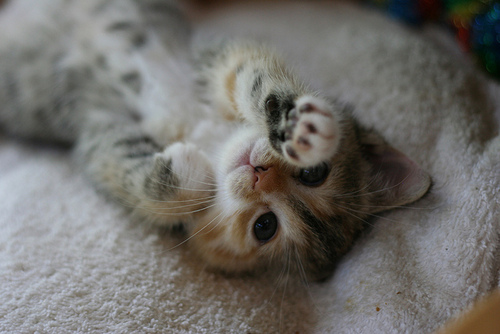A guide to help cat owners understand what their pets are thinking from their body language has been released by a cat charity. telegraph.co.uk share the info:
Animal behaviour experts have worked with Cats Protection to produce a guide to help pet owners know what their cats want.
It helps explain often contradictory behaviour by these precious animals – like why they often scratch and bite when they appear to want their stomachs rubbed.
The guide also includes advice about how to respond to these signals and common misinterpretations made by cat owners.
Among the signals they say to look out for are:
• The greeting – when the cat walks towards you with its tail up, it means it is saying hello The sign of trust – when the cat rolls on its back exposing its stomach it is showing it trusts you rather than wanting its belly rubbed.
• The leg rub – when the cats rubs its head and body against your legs it is saying you smell strange and is trying to mark you with its scent
• Flattened ears – when the cat flattens its ears it is frightened and needs somewhere to hide
• Licking of lips – while after eating this can just be it is cleaning itself, at other times it can be a sign of nausea or stress
• The slow blink – the cat will slowly close and open its eyes, turning its head to one side, meaning it is relaxed and is not feeling threatened
Nicky Trevorrow, Cat Protection’s behaviour manager, said: “They are quite complicated and subtle in their behaviour, much more so than social species like ourselves and dogs.
“When a cat throws itself on its side and shows its belly, most people misinterpret this behaviour and think that it wants its belly rubbed but will get grabbed by their hand and the cat will bite them.
“What the cat is actually doing is showing a greeting behaviour and showing trust. It is actually an abuse of that trust to stroke its belly. What the cat would rather you do is to give it a slight head rub.
“When a cat comes towards you with their tail upwards, it is a sign of their greeting. The best thing to do is to acknowledge their greeting and give their head a rub."
The charity produced the short three minute video guide after conducting a survey of 1,100 cat owners to see what they thought their pets were trying to communicate.
Three quarters of those asked did not know that the cat’s upright tail meant it was pleased to see them, while a third thought a cat wanted its tummy tickled when it lies on its back.
A third of owners also failed to recognise a slow-blinking cat as meaning they were content and 65 per cent thought a purring cat means it is always happy, but it can also be a sign of pain.
Half of owners were unaware that cats show stress by licking their lips and a quarter thought cats shed hair intentionally to mark their territory.
Mrs Trevorrow added: “If a cat is stressed it is really important to give them a place to hide and to get up high."
A recent study showed that dogs make subtle facial expressions that help to convey how they are feeling.
Mrs Trevorrow added: "Unlike dogs and humans, cats have not evolved the complex facial muscles that allow them to make obvious expressions.
"They are more subtle and can be difficult to read, so owners also need to look for non-facial signals that can indicate how their cat is feeling.”
Fuente: www.telegraph.co.uk
